Exploring Public Health Concerns Arising from Wastewater Reuse
VerifiedAdded on 2023/06/03
|13
|3709
|447
Literature Review
AI Summary
This literature review delves into the public health concerns associated with wastewater reuse, particularly focusing on irrigation and toilet flushing. It highlights both the positive aspects, such as increased food security in impoverished areas, and the negative impacts, including the transmission of pathogens and hazardous chemicals. The review discusses various exposure pathways, such as the consumption of contaminated crops and direct contact with wastewater in agricultural settings, emphasizing the vulnerability of children. It also addresses mitigation strategies, including conventional and non-conventional wastewater treatment methods, the multiple-barrier approach, and the importance of public education and awareness. The review concludes by stressing the need for a balanced approach that considers both the benefits of wastewater reuse and the imperative to minimize health risks, advocating for context-specific solutions and continuous monitoring to safeguard public health. Desklib offers a platform to explore similar assignments and study resources.
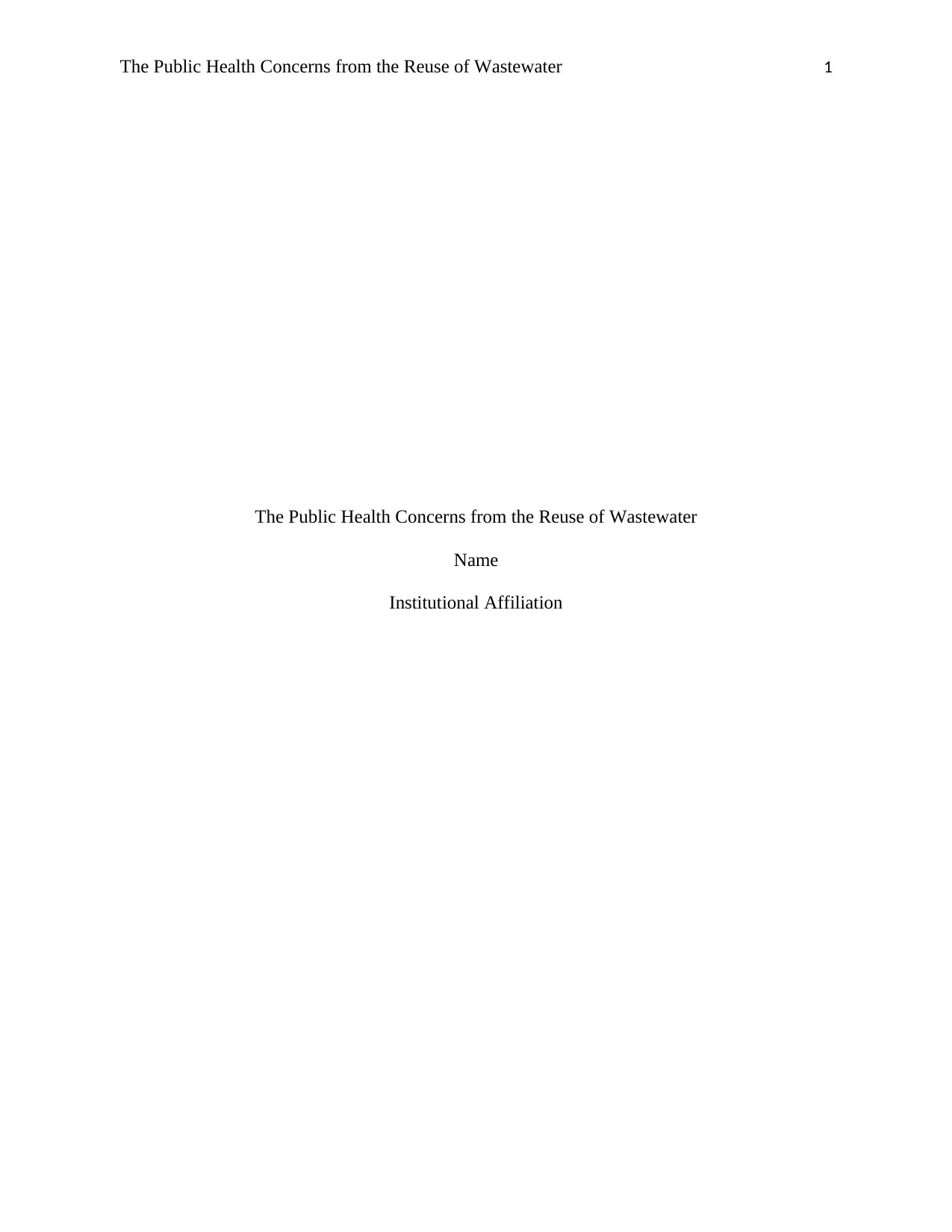
The Public Health Concerns from the Reuse of Wastewater 1
The Public Health Concerns from the Reuse of Wastewater
Name
Institutional Affiliation
The Public Health Concerns from the Reuse of Wastewater
Name
Institutional Affiliation
Paraphrase This Document
Need a fresh take? Get an instant paraphrase of this document with our AI Paraphraser
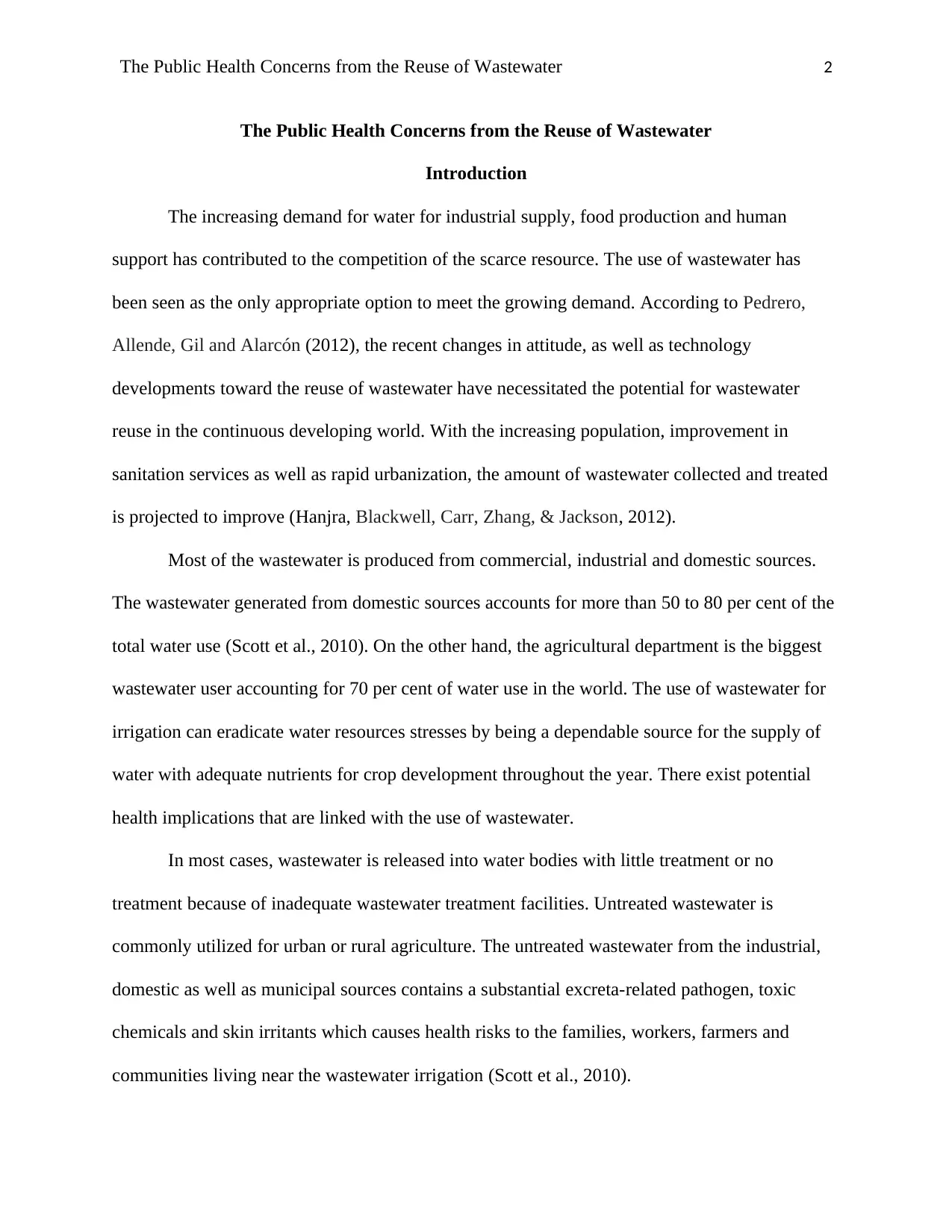
The Public Health Concerns from the Reuse of Wastewater 2
The Public Health Concerns from the Reuse of Wastewater
Introduction
The increasing demand for water for industrial supply, food production and human
support has contributed to the competition of the scarce resource. The use of wastewater has
been seen as the only appropriate option to meet the growing demand. According to Pedrero,
Allende, Gil and Alarcón (2012), the recent changes in attitude, as well as technology
developments toward the reuse of wastewater have necessitated the potential for wastewater
reuse in the continuous developing world. With the increasing population, improvement in
sanitation services as well as rapid urbanization, the amount of wastewater collected and treated
is projected to improve (Hanjra, Blackwell, Carr, Zhang, & Jackson, 2012).
Most of the wastewater is produced from commercial, industrial and domestic sources.
The wastewater generated from domestic sources accounts for more than 50 to 80 per cent of the
total water use (Scott et al., 2010). On the other hand, the agricultural department is the biggest
wastewater user accounting for 70 per cent of water use in the world. The use of wastewater for
irrigation can eradicate water resources stresses by being a dependable source for the supply of
water with adequate nutrients for crop development throughout the year. There exist potential
health implications that are linked with the use of wastewater.
In most cases, wastewater is released into water bodies with little treatment or no
treatment because of inadequate wastewater treatment facilities. Untreated wastewater is
commonly utilized for urban or rural agriculture. The untreated wastewater from the industrial,
domestic as well as municipal sources contains a substantial excreta-related pathogen, toxic
chemicals and skin irritants which causes health risks to the families, workers, farmers and
communities living near the wastewater irrigation (Scott et al., 2010).
The Public Health Concerns from the Reuse of Wastewater
Introduction
The increasing demand for water for industrial supply, food production and human
support has contributed to the competition of the scarce resource. The use of wastewater has
been seen as the only appropriate option to meet the growing demand. According to Pedrero,
Allende, Gil and Alarcón (2012), the recent changes in attitude, as well as technology
developments toward the reuse of wastewater have necessitated the potential for wastewater
reuse in the continuous developing world. With the increasing population, improvement in
sanitation services as well as rapid urbanization, the amount of wastewater collected and treated
is projected to improve (Hanjra, Blackwell, Carr, Zhang, & Jackson, 2012).
Most of the wastewater is produced from commercial, industrial and domestic sources.
The wastewater generated from domestic sources accounts for more than 50 to 80 per cent of the
total water use (Scott et al., 2010). On the other hand, the agricultural department is the biggest
wastewater user accounting for 70 per cent of water use in the world. The use of wastewater for
irrigation can eradicate water resources stresses by being a dependable source for the supply of
water with adequate nutrients for crop development throughout the year. There exist potential
health implications that are linked with the use of wastewater.
In most cases, wastewater is released into water bodies with little treatment or no
treatment because of inadequate wastewater treatment facilities. Untreated wastewater is
commonly utilized for urban or rural agriculture. The untreated wastewater from the industrial,
domestic as well as municipal sources contains a substantial excreta-related pathogen, toxic
chemicals and skin irritants which causes health risks to the families, workers, farmers and
communities living near the wastewater irrigation (Scott et al., 2010).
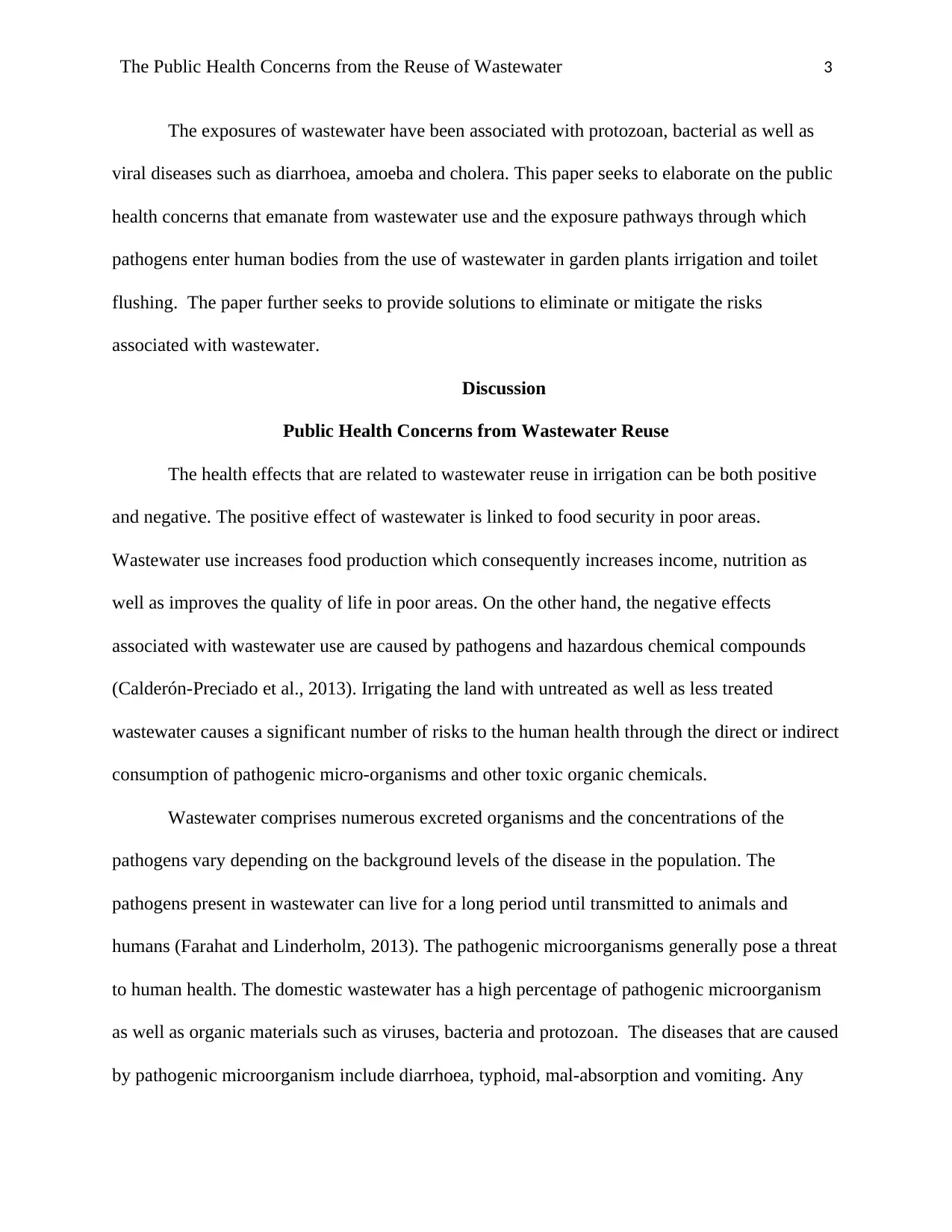
The Public Health Concerns from the Reuse of Wastewater 3
The exposures of wastewater have been associated with protozoan, bacterial as well as
viral diseases such as diarrhoea, amoeba and cholera. This paper seeks to elaborate on the public
health concerns that emanate from wastewater use and the exposure pathways through which
pathogens enter human bodies from the use of wastewater in garden plants irrigation and toilet
flushing. The paper further seeks to provide solutions to eliminate or mitigate the risks
associated with wastewater.
Discussion
Public Health Concerns from Wastewater Reuse
The health effects that are related to wastewater reuse in irrigation can be both positive
and negative. The positive effect of wastewater is linked to food security in poor areas.
Wastewater use increases food production which consequently increases income, nutrition as
well as improves the quality of life in poor areas. On the other hand, the negative effects
associated with wastewater use are caused by pathogens and hazardous chemical compounds
(Calderón-Preciado et al., 2013). Irrigating the land with untreated as well as less treated
wastewater causes a significant number of risks to the human health through the direct or indirect
consumption of pathogenic micro-organisms and other toxic organic chemicals.
Wastewater comprises numerous excreted organisms and the concentrations of the
pathogens vary depending on the background levels of the disease in the population. The
pathogens present in wastewater can live for a long period until transmitted to animals and
humans (Farahat and Linderholm, 2013). The pathogenic microorganisms generally pose a threat
to human health. The domestic wastewater has a high percentage of pathogenic microorganism
as well as organic materials such as viruses, bacteria and protozoan. The diseases that are caused
by pathogenic microorganism include diarrhoea, typhoid, mal-absorption and vomiting. Any
The exposures of wastewater have been associated with protozoan, bacterial as well as
viral diseases such as diarrhoea, amoeba and cholera. This paper seeks to elaborate on the public
health concerns that emanate from wastewater use and the exposure pathways through which
pathogens enter human bodies from the use of wastewater in garden plants irrigation and toilet
flushing. The paper further seeks to provide solutions to eliminate or mitigate the risks
associated with wastewater.
Discussion
Public Health Concerns from Wastewater Reuse
The health effects that are related to wastewater reuse in irrigation can be both positive
and negative. The positive effect of wastewater is linked to food security in poor areas.
Wastewater use increases food production which consequently increases income, nutrition as
well as improves the quality of life in poor areas. On the other hand, the negative effects
associated with wastewater use are caused by pathogens and hazardous chemical compounds
(Calderón-Preciado et al., 2013). Irrigating the land with untreated as well as less treated
wastewater causes a significant number of risks to the human health through the direct or indirect
consumption of pathogenic micro-organisms and other toxic organic chemicals.
Wastewater comprises numerous excreted organisms and the concentrations of the
pathogens vary depending on the background levels of the disease in the population. The
pathogens present in wastewater can live for a long period until transmitted to animals and
humans (Farahat and Linderholm, 2013). The pathogenic microorganisms generally pose a threat
to human health. The domestic wastewater has a high percentage of pathogenic microorganism
as well as organic materials such as viruses, bacteria and protozoan. The diseases that are caused
by pathogenic microorganism include diarrhoea, typhoid, mal-absorption and vomiting. Any
⊘ This is a preview!⊘
Do you want full access?
Subscribe today to unlock all pages.

Trusted by 1+ million students worldwide
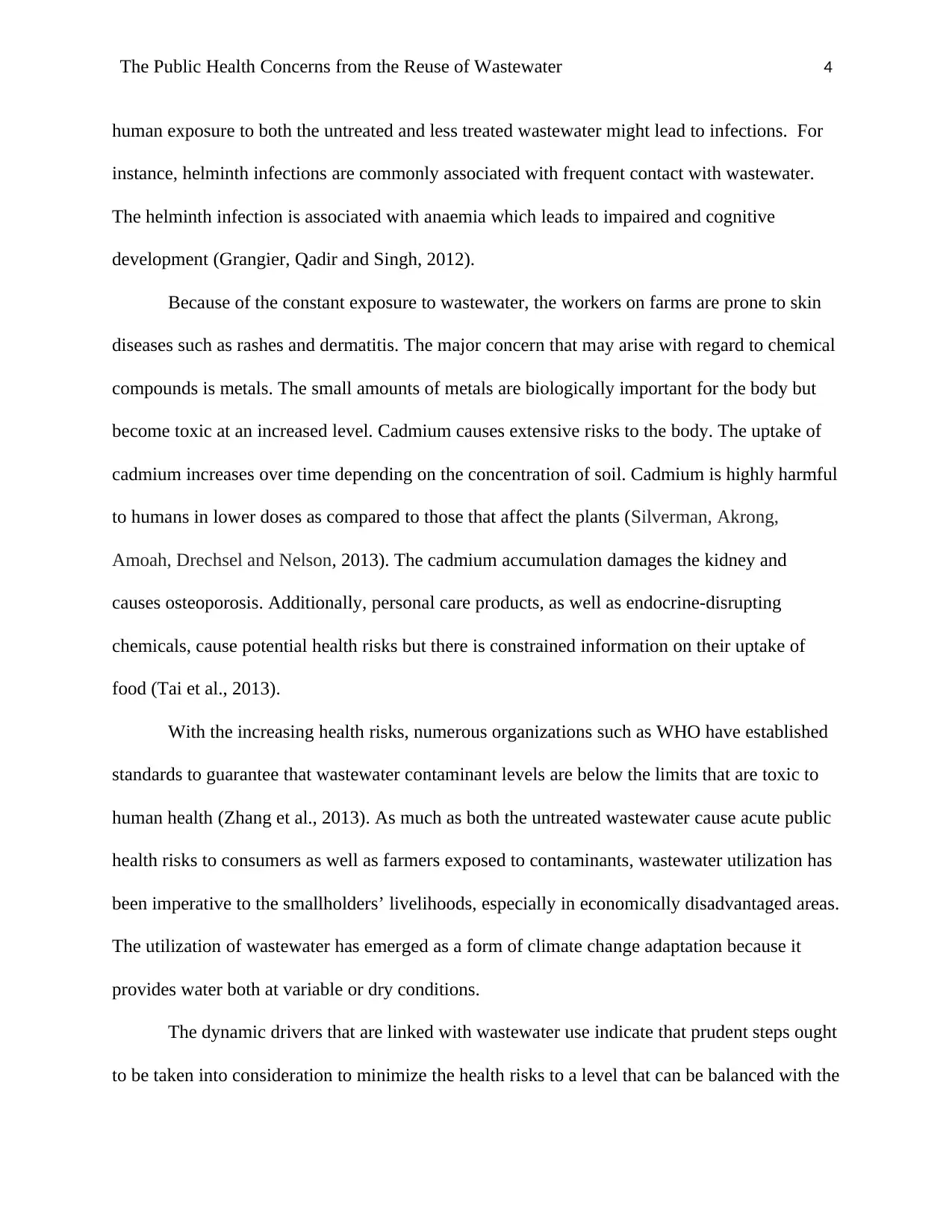
The Public Health Concerns from the Reuse of Wastewater 4
human exposure to both the untreated and less treated wastewater might lead to infections. For
instance, helminth infections are commonly associated with frequent contact with wastewater.
The helminth infection is associated with anaemia which leads to impaired and cognitive
development (Grangier, Qadir and Singh, 2012).
Because of the constant exposure to wastewater, the workers on farms are prone to skin
diseases such as rashes and dermatitis. The major concern that may arise with regard to chemical
compounds is metals. The small amounts of metals are biologically important for the body but
become toxic at an increased level. Cadmium causes extensive risks to the body. The uptake of
cadmium increases over time depending on the concentration of soil. Cadmium is highly harmful
to humans in lower doses as compared to those that affect the plants (Silverman, Akrong,
Amoah, Drechsel and Nelson, 2013). The cadmium accumulation damages the kidney and
causes osteoporosis. Additionally, personal care products, as well as endocrine-disrupting
chemicals, cause potential health risks but there is constrained information on their uptake of
food (Tai et al., 2013).
With the increasing health risks, numerous organizations such as WHO have established
standards to guarantee that wastewater contaminant levels are below the limits that are toxic to
human health (Zhang et al., 2013). As much as both the untreated wastewater cause acute public
health risks to consumers as well as farmers exposed to contaminants, wastewater utilization has
been imperative to the smallholders’ livelihoods, especially in economically disadvantaged areas.
The utilization of wastewater has emerged as a form of climate change adaptation because it
provides water both at variable or dry conditions.
The dynamic drivers that are linked with wastewater use indicate that prudent steps ought
to be taken into consideration to minimize the health risks to a level that can be balanced with the
human exposure to both the untreated and less treated wastewater might lead to infections. For
instance, helminth infections are commonly associated with frequent contact with wastewater.
The helminth infection is associated with anaemia which leads to impaired and cognitive
development (Grangier, Qadir and Singh, 2012).
Because of the constant exposure to wastewater, the workers on farms are prone to skin
diseases such as rashes and dermatitis. The major concern that may arise with regard to chemical
compounds is metals. The small amounts of metals are biologically important for the body but
become toxic at an increased level. Cadmium causes extensive risks to the body. The uptake of
cadmium increases over time depending on the concentration of soil. Cadmium is highly harmful
to humans in lower doses as compared to those that affect the plants (Silverman, Akrong,
Amoah, Drechsel and Nelson, 2013). The cadmium accumulation damages the kidney and
causes osteoporosis. Additionally, personal care products, as well as endocrine-disrupting
chemicals, cause potential health risks but there is constrained information on their uptake of
food (Tai et al., 2013).
With the increasing health risks, numerous organizations such as WHO have established
standards to guarantee that wastewater contaminant levels are below the limits that are toxic to
human health (Zhang et al., 2013). As much as both the untreated wastewater cause acute public
health risks to consumers as well as farmers exposed to contaminants, wastewater utilization has
been imperative to the smallholders’ livelihoods, especially in economically disadvantaged areas.
The utilization of wastewater has emerged as a form of climate change adaptation because it
provides water both at variable or dry conditions.
The dynamic drivers that are linked with wastewater use indicate that prudent steps ought
to be taken into consideration to minimize the health risks to a level that can be balanced with the
Paraphrase This Document
Need a fresh take? Get an instant paraphrase of this document with our AI Paraphraser
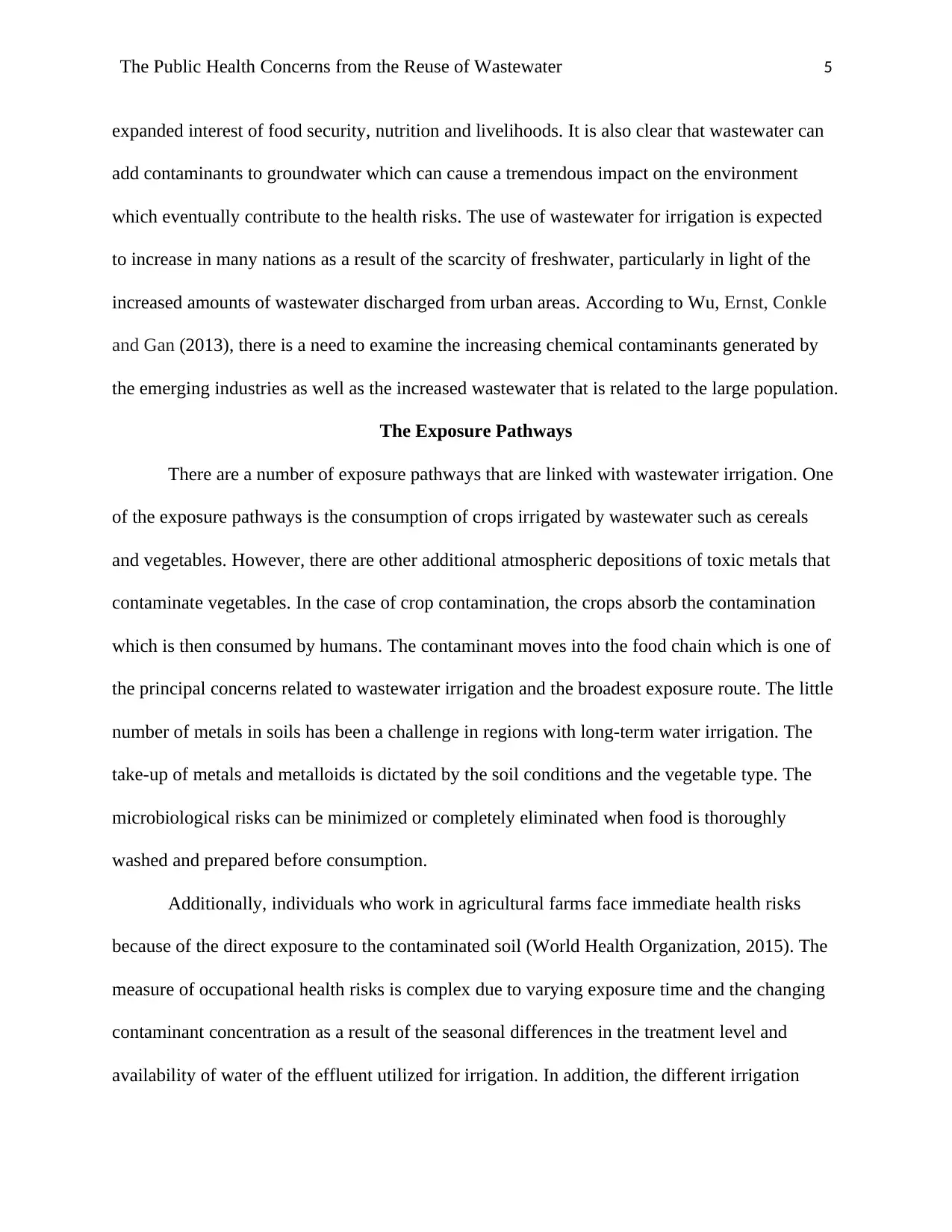
The Public Health Concerns from the Reuse of Wastewater 5
expanded interest of food security, nutrition and livelihoods. It is also clear that wastewater can
add contaminants to groundwater which can cause a tremendous impact on the environment
which eventually contribute to the health risks. The use of wastewater for irrigation is expected
to increase in many nations as a result of the scarcity of freshwater, particularly in light of the
increased amounts of wastewater discharged from urban areas. According to Wu, Ernst, Conkle
and Gan (2013), there is a need to examine the increasing chemical contaminants generated by
the emerging industries as well as the increased wastewater that is related to the large population.
The Exposure Pathways
There are a number of exposure pathways that are linked with wastewater irrigation. One
of the exposure pathways is the consumption of crops irrigated by wastewater such as cereals
and vegetables. However, there are other additional atmospheric depositions of toxic metals that
contaminate vegetables. In the case of crop contamination, the crops absorb the contamination
which is then consumed by humans. The contaminant moves into the food chain which is one of
the principal concerns related to wastewater irrigation and the broadest exposure route. The little
number of metals in soils has been a challenge in regions with long-term water irrigation. The
take-up of metals and metalloids is dictated by the soil conditions and the vegetable type. The
microbiological risks can be minimized or completely eliminated when food is thoroughly
washed and prepared before consumption.
Additionally, individuals who work in agricultural farms face immediate health risks
because of the direct exposure to the contaminated soil (World Health Organization, 2015). The
measure of occupational health risks is complex due to varying exposure time and the changing
contaminant concentration as a result of the seasonal differences in the treatment level and
availability of water of the effluent utilized for irrigation. In addition, the different irrigation
expanded interest of food security, nutrition and livelihoods. It is also clear that wastewater can
add contaminants to groundwater which can cause a tremendous impact on the environment
which eventually contribute to the health risks. The use of wastewater for irrigation is expected
to increase in many nations as a result of the scarcity of freshwater, particularly in light of the
increased amounts of wastewater discharged from urban areas. According to Wu, Ernst, Conkle
and Gan (2013), there is a need to examine the increasing chemical contaminants generated by
the emerging industries as well as the increased wastewater that is related to the large population.
The Exposure Pathways
There are a number of exposure pathways that are linked with wastewater irrigation. One
of the exposure pathways is the consumption of crops irrigated by wastewater such as cereals
and vegetables. However, there are other additional atmospheric depositions of toxic metals that
contaminate vegetables. In the case of crop contamination, the crops absorb the contamination
which is then consumed by humans. The contaminant moves into the food chain which is one of
the principal concerns related to wastewater irrigation and the broadest exposure route. The little
number of metals in soils has been a challenge in regions with long-term water irrigation. The
take-up of metals and metalloids is dictated by the soil conditions and the vegetable type. The
microbiological risks can be minimized or completely eliminated when food is thoroughly
washed and prepared before consumption.
Additionally, individuals who work in agricultural farms face immediate health risks
because of the direct exposure to the contaminated soil (World Health Organization, 2015). The
measure of occupational health risks is complex due to varying exposure time and the changing
contaminant concentration as a result of the seasonal differences in the treatment level and
availability of water of the effluent utilized for irrigation. In addition, the different irrigation
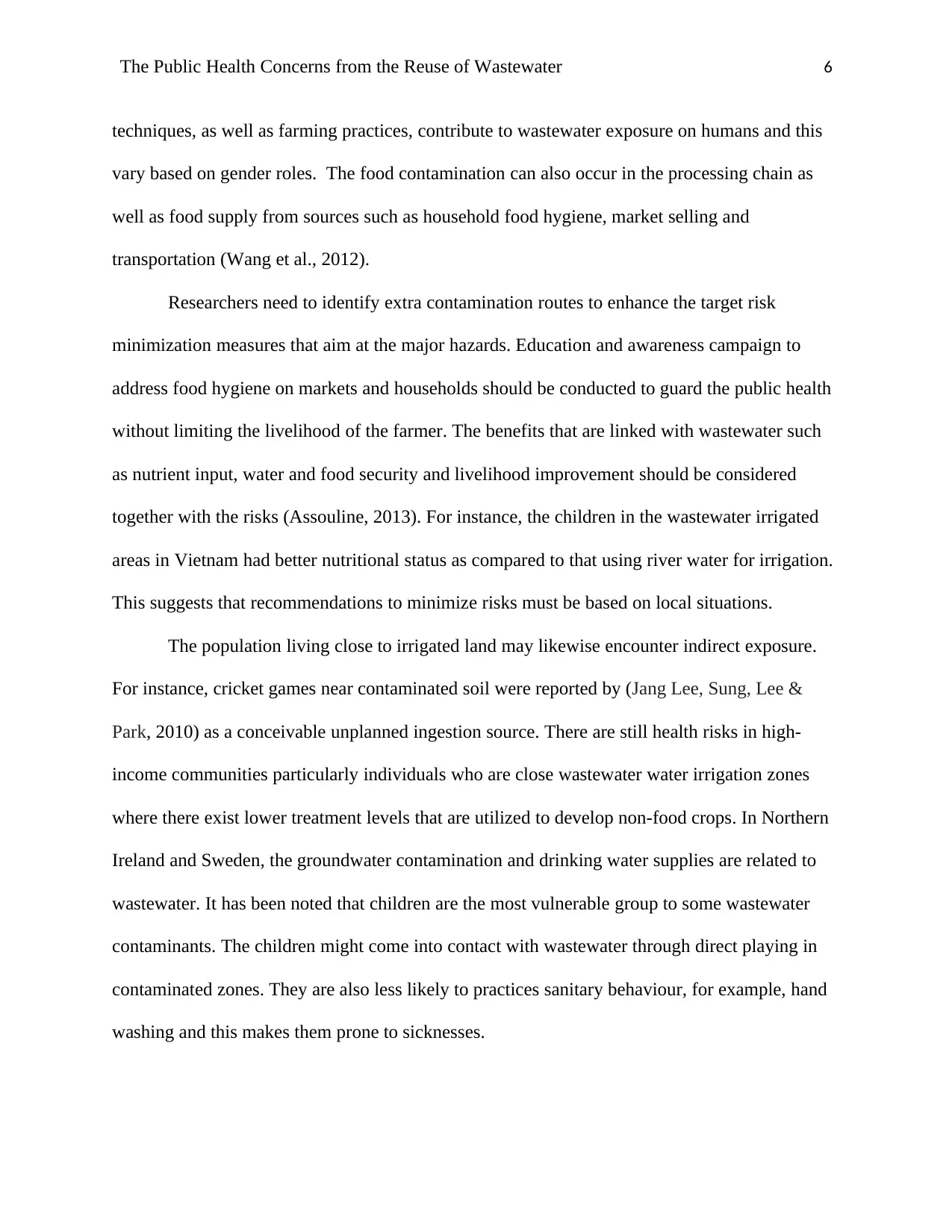
The Public Health Concerns from the Reuse of Wastewater 6
techniques, as well as farming practices, contribute to wastewater exposure on humans and this
vary based on gender roles. The food contamination can also occur in the processing chain as
well as food supply from sources such as household food hygiene, market selling and
transportation (Wang et al., 2012).
Researchers need to identify extra contamination routes to enhance the target risk
minimization measures that aim at the major hazards. Education and awareness campaign to
address food hygiene on markets and households should be conducted to guard the public health
without limiting the livelihood of the farmer. The benefits that are linked with wastewater such
as nutrient input, water and food security and livelihood improvement should be considered
together with the risks (Assouline, 2013). For instance, the children in the wastewater irrigated
areas in Vietnam had better nutritional status as compared to that using river water for irrigation.
This suggests that recommendations to minimize risks must be based on local situations.
The population living close to irrigated land may likewise encounter indirect exposure.
For instance, cricket games near contaminated soil were reported by (Jang Lee, Sung, Lee &
Park, 2010) as a conceivable unplanned ingestion source. There are still health risks in high-
income communities particularly individuals who are close wastewater water irrigation zones
where there exist lower treatment levels that are utilized to develop non-food crops. In Northern
Ireland and Sweden, the groundwater contamination and drinking water supplies are related to
wastewater. It has been noted that children are the most vulnerable group to some wastewater
contaminants. The children might come into contact with wastewater through direct playing in
contaminated zones. They are also less likely to practices sanitary behaviour, for example, hand
washing and this makes them prone to sicknesses.
techniques, as well as farming practices, contribute to wastewater exposure on humans and this
vary based on gender roles. The food contamination can also occur in the processing chain as
well as food supply from sources such as household food hygiene, market selling and
transportation (Wang et al., 2012).
Researchers need to identify extra contamination routes to enhance the target risk
minimization measures that aim at the major hazards. Education and awareness campaign to
address food hygiene on markets and households should be conducted to guard the public health
without limiting the livelihood of the farmer. The benefits that are linked with wastewater such
as nutrient input, water and food security and livelihood improvement should be considered
together with the risks (Assouline, 2013). For instance, the children in the wastewater irrigated
areas in Vietnam had better nutritional status as compared to that using river water for irrigation.
This suggests that recommendations to minimize risks must be based on local situations.
The population living close to irrigated land may likewise encounter indirect exposure.
For instance, cricket games near contaminated soil were reported by (Jang Lee, Sung, Lee &
Park, 2010) as a conceivable unplanned ingestion source. There are still health risks in high-
income communities particularly individuals who are close wastewater water irrigation zones
where there exist lower treatment levels that are utilized to develop non-food crops. In Northern
Ireland and Sweden, the groundwater contamination and drinking water supplies are related to
wastewater. It has been noted that children are the most vulnerable group to some wastewater
contaminants. The children might come into contact with wastewater through direct playing in
contaminated zones. They are also less likely to practices sanitary behaviour, for example, hand
washing and this makes them prone to sicknesses.
⊘ This is a preview!⊘
Do you want full access?
Subscribe today to unlock all pages.

Trusted by 1+ million students worldwide
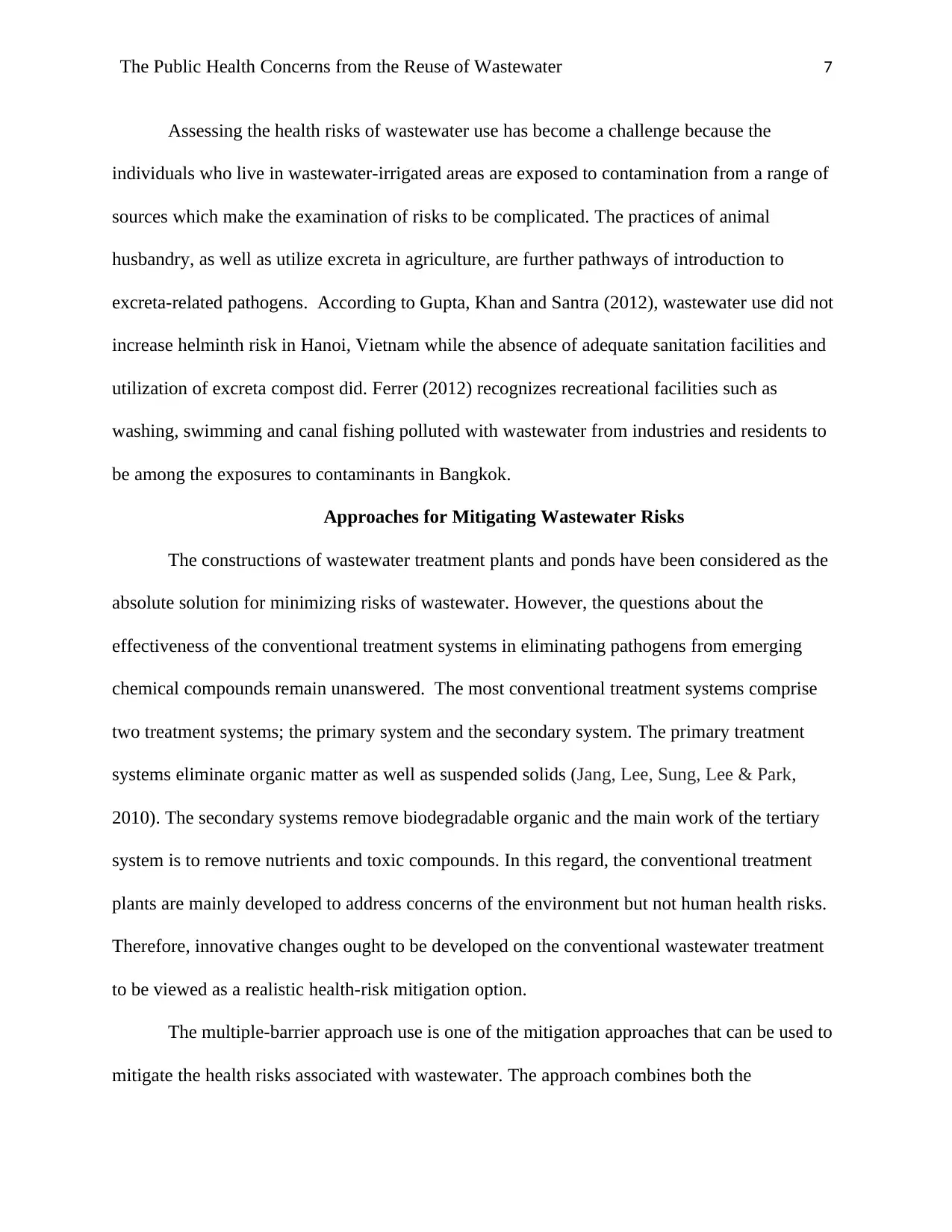
The Public Health Concerns from the Reuse of Wastewater 7
Assessing the health risks of wastewater use has become a challenge because the
individuals who live in wastewater-irrigated areas are exposed to contamination from a range of
sources which make the examination of risks to be complicated. The practices of animal
husbandry, as well as utilize excreta in agriculture, are further pathways of introduction to
excreta-related pathogens. According to Gupta, Khan and Santra (2012), wastewater use did not
increase helminth risk in Hanoi, Vietnam while the absence of adequate sanitation facilities and
utilization of excreta compost did. Ferrer (2012) recognizes recreational facilities such as
washing, swimming and canal fishing polluted with wastewater from industries and residents to
be among the exposures to contaminants in Bangkok.
Approaches for Mitigating Wastewater Risks
The constructions of wastewater treatment plants and ponds have been considered as the
absolute solution for minimizing risks of wastewater. However, the questions about the
effectiveness of the conventional treatment systems in eliminating pathogens from emerging
chemical compounds remain unanswered. The most conventional treatment systems comprise
two treatment systems; the primary system and the secondary system. The primary treatment
systems eliminate organic matter as well as suspended solids (Jang, Lee, Sung, Lee & Park,
2010). The secondary systems remove biodegradable organic and the main work of the tertiary
system is to remove nutrients and toxic compounds. In this regard, the conventional treatment
plants are mainly developed to address concerns of the environment but not human health risks.
Therefore, innovative changes ought to be developed on the conventional wastewater treatment
to be viewed as a realistic health-risk mitigation option.
The multiple-barrier approach use is one of the mitigation approaches that can be used to
mitigate the health risks associated with wastewater. The approach combines both the
Assessing the health risks of wastewater use has become a challenge because the
individuals who live in wastewater-irrigated areas are exposed to contamination from a range of
sources which make the examination of risks to be complicated. The practices of animal
husbandry, as well as utilize excreta in agriculture, are further pathways of introduction to
excreta-related pathogens. According to Gupta, Khan and Santra (2012), wastewater use did not
increase helminth risk in Hanoi, Vietnam while the absence of adequate sanitation facilities and
utilization of excreta compost did. Ferrer (2012) recognizes recreational facilities such as
washing, swimming and canal fishing polluted with wastewater from industries and residents to
be among the exposures to contaminants in Bangkok.
Approaches for Mitigating Wastewater Risks
The constructions of wastewater treatment plants and ponds have been considered as the
absolute solution for minimizing risks of wastewater. However, the questions about the
effectiveness of the conventional treatment systems in eliminating pathogens from emerging
chemical compounds remain unanswered. The most conventional treatment systems comprise
two treatment systems; the primary system and the secondary system. The primary treatment
systems eliminate organic matter as well as suspended solids (Jang, Lee, Sung, Lee & Park,
2010). The secondary systems remove biodegradable organic and the main work of the tertiary
system is to remove nutrients and toxic compounds. In this regard, the conventional treatment
plants are mainly developed to address concerns of the environment but not human health risks.
Therefore, innovative changes ought to be developed on the conventional wastewater treatment
to be viewed as a realistic health-risk mitigation option.
The multiple-barrier approach use is one of the mitigation approaches that can be used to
mitigate the health risks associated with wastewater. The approach combines both the
Paraphrase This Document
Need a fresh take? Get an instant paraphrase of this document with our AI Paraphraser
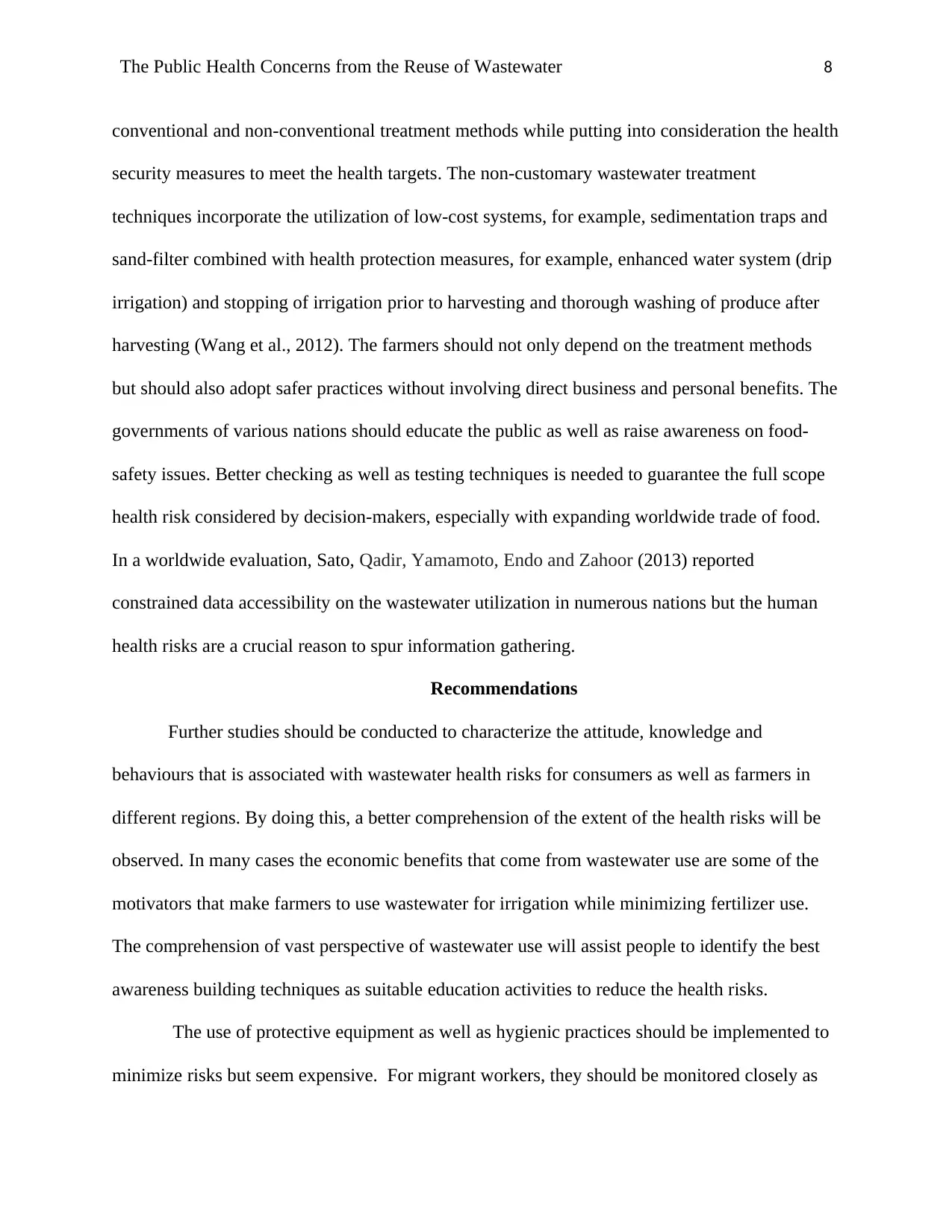
The Public Health Concerns from the Reuse of Wastewater 8
conventional and non-conventional treatment methods while putting into consideration the health
security measures to meet the health targets. The non-customary wastewater treatment
techniques incorporate the utilization of low-cost systems, for example, sedimentation traps and
sand-filter combined with health protection measures, for example, enhanced water system (drip
irrigation) and stopping of irrigation prior to harvesting and thorough washing of produce after
harvesting (Wang et al., 2012). The farmers should not only depend on the treatment methods
but should also adopt safer practices without involving direct business and personal benefits. The
governments of various nations should educate the public as well as raise awareness on food-
safety issues. Better checking as well as testing techniques is needed to guarantee the full scope
health risk considered by decision-makers, especially with expanding worldwide trade of food.
In a worldwide evaluation, Sato, Qadir, Yamamoto, Endo and Zahoor (2013) reported
constrained data accessibility on the wastewater utilization in numerous nations but the human
health risks are a crucial reason to spur information gathering.
Recommendations
Further studies should be conducted to characterize the attitude, knowledge and
behaviours that is associated with wastewater health risks for consumers as well as farmers in
different regions. By doing this, a better comprehension of the extent of the health risks will be
observed. In many cases the economic benefits that come from wastewater use are some of the
motivators that make farmers to use wastewater for irrigation while minimizing fertilizer use.
The comprehension of vast perspective of wastewater use will assist people to identify the best
awareness building techniques as suitable education activities to reduce the health risks.
The use of protective equipment as well as hygienic practices should be implemented to
minimize risks but seem expensive. For migrant workers, they should be monitored closely as
conventional and non-conventional treatment methods while putting into consideration the health
security measures to meet the health targets. The non-customary wastewater treatment
techniques incorporate the utilization of low-cost systems, for example, sedimentation traps and
sand-filter combined with health protection measures, for example, enhanced water system (drip
irrigation) and stopping of irrigation prior to harvesting and thorough washing of produce after
harvesting (Wang et al., 2012). The farmers should not only depend on the treatment methods
but should also adopt safer practices without involving direct business and personal benefits. The
governments of various nations should educate the public as well as raise awareness on food-
safety issues. Better checking as well as testing techniques is needed to guarantee the full scope
health risk considered by decision-makers, especially with expanding worldwide trade of food.
In a worldwide evaluation, Sato, Qadir, Yamamoto, Endo and Zahoor (2013) reported
constrained data accessibility on the wastewater utilization in numerous nations but the human
health risks are a crucial reason to spur information gathering.
Recommendations
Further studies should be conducted to characterize the attitude, knowledge and
behaviours that is associated with wastewater health risks for consumers as well as farmers in
different regions. By doing this, a better comprehension of the extent of the health risks will be
observed. In many cases the economic benefits that come from wastewater use are some of the
motivators that make farmers to use wastewater for irrigation while minimizing fertilizer use.
The comprehension of vast perspective of wastewater use will assist people to identify the best
awareness building techniques as suitable education activities to reduce the health risks.
The use of protective equipment as well as hygienic practices should be implemented to
minimize risks but seem expensive. For migrant workers, they should be monitored closely as
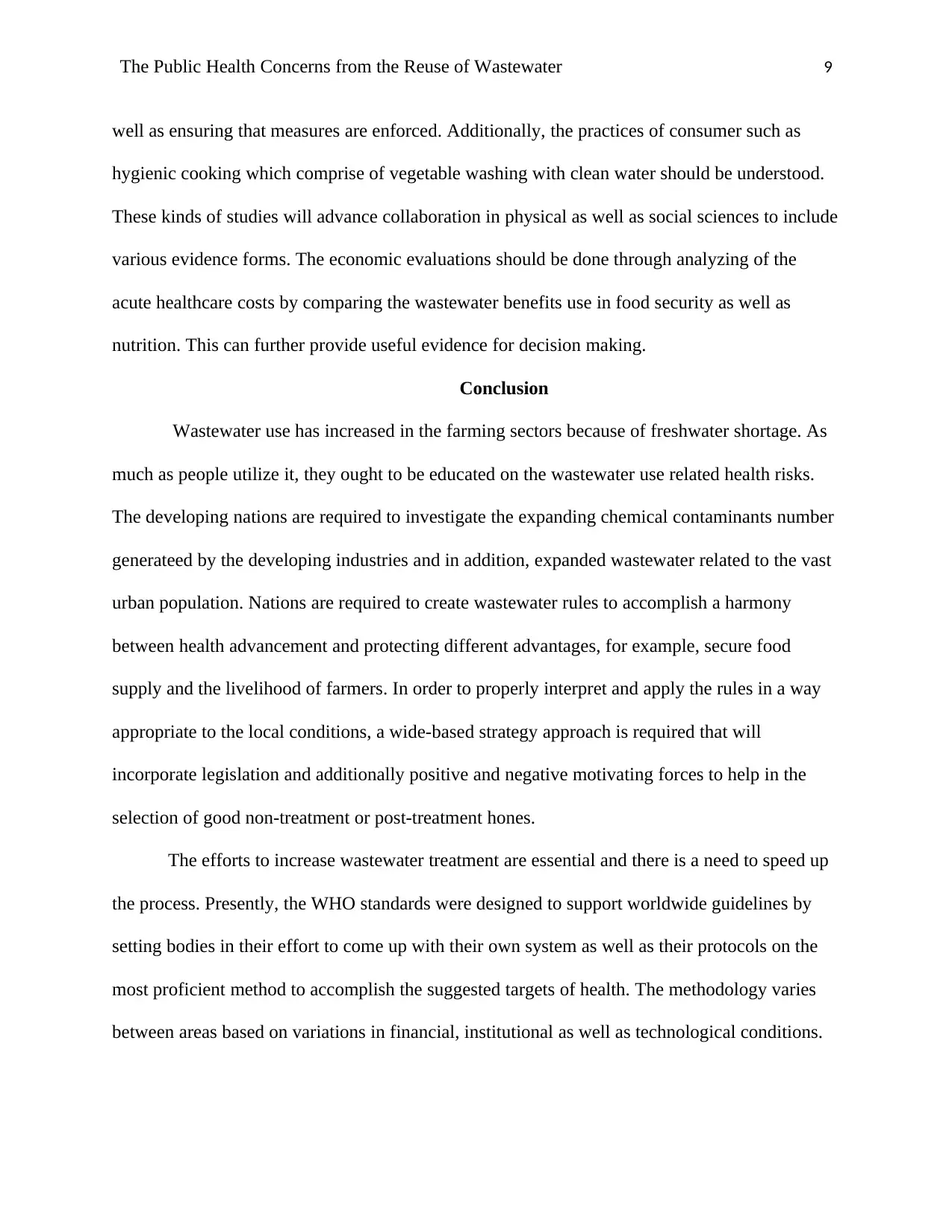
The Public Health Concerns from the Reuse of Wastewater 9
well as ensuring that measures are enforced. Additionally, the practices of consumer such as
hygienic cooking which comprise of vegetable washing with clean water should be understood.
These kinds of studies will advance collaboration in physical as well as social sciences to include
various evidence forms. The economic evaluations should be done through analyzing of the
acute healthcare costs by comparing the wastewater benefits use in food security as well as
nutrition. This can further provide useful evidence for decision making.
Conclusion
Wastewater use has increased in the farming sectors because of freshwater shortage. As
much as people utilize it, they ought to be educated on the wastewater use related health risks.
The developing nations are required to investigate the expanding chemical contaminants number
generateed by the developing industries and in addition, expanded wastewater related to the vast
urban population. Nations are required to create wastewater rules to accomplish a harmony
between health advancement and protecting different advantages, for example, secure food
supply and the livelihood of farmers. In order to properly interpret and apply the rules in a way
appropriate to the local conditions, a wide-based strategy approach is required that will
incorporate legislation and additionally positive and negative motivating forces to help in the
selection of good non-treatment or post-treatment hones.
The efforts to increase wastewater treatment are essential and there is a need to speed up
the process. Presently, the WHO standards were designed to support worldwide guidelines by
setting bodies in their effort to come up with their own system as well as their protocols on the
most proficient method to accomplish the suggested targets of health. The methodology varies
between areas based on variations in financial, institutional as well as technological conditions.
well as ensuring that measures are enforced. Additionally, the practices of consumer such as
hygienic cooking which comprise of vegetable washing with clean water should be understood.
These kinds of studies will advance collaboration in physical as well as social sciences to include
various evidence forms. The economic evaluations should be done through analyzing of the
acute healthcare costs by comparing the wastewater benefits use in food security as well as
nutrition. This can further provide useful evidence for decision making.
Conclusion
Wastewater use has increased in the farming sectors because of freshwater shortage. As
much as people utilize it, they ought to be educated on the wastewater use related health risks.
The developing nations are required to investigate the expanding chemical contaminants number
generateed by the developing industries and in addition, expanded wastewater related to the vast
urban population. Nations are required to create wastewater rules to accomplish a harmony
between health advancement and protecting different advantages, for example, secure food
supply and the livelihood of farmers. In order to properly interpret and apply the rules in a way
appropriate to the local conditions, a wide-based strategy approach is required that will
incorporate legislation and additionally positive and negative motivating forces to help in the
selection of good non-treatment or post-treatment hones.
The efforts to increase wastewater treatment are essential and there is a need to speed up
the process. Presently, the WHO standards were designed to support worldwide guidelines by
setting bodies in their effort to come up with their own system as well as their protocols on the
most proficient method to accomplish the suggested targets of health. The methodology varies
between areas based on variations in financial, institutional as well as technological conditions.
⊘ This is a preview!⊘
Do you want full access?
Subscribe today to unlock all pages.

Trusted by 1+ million students worldwide
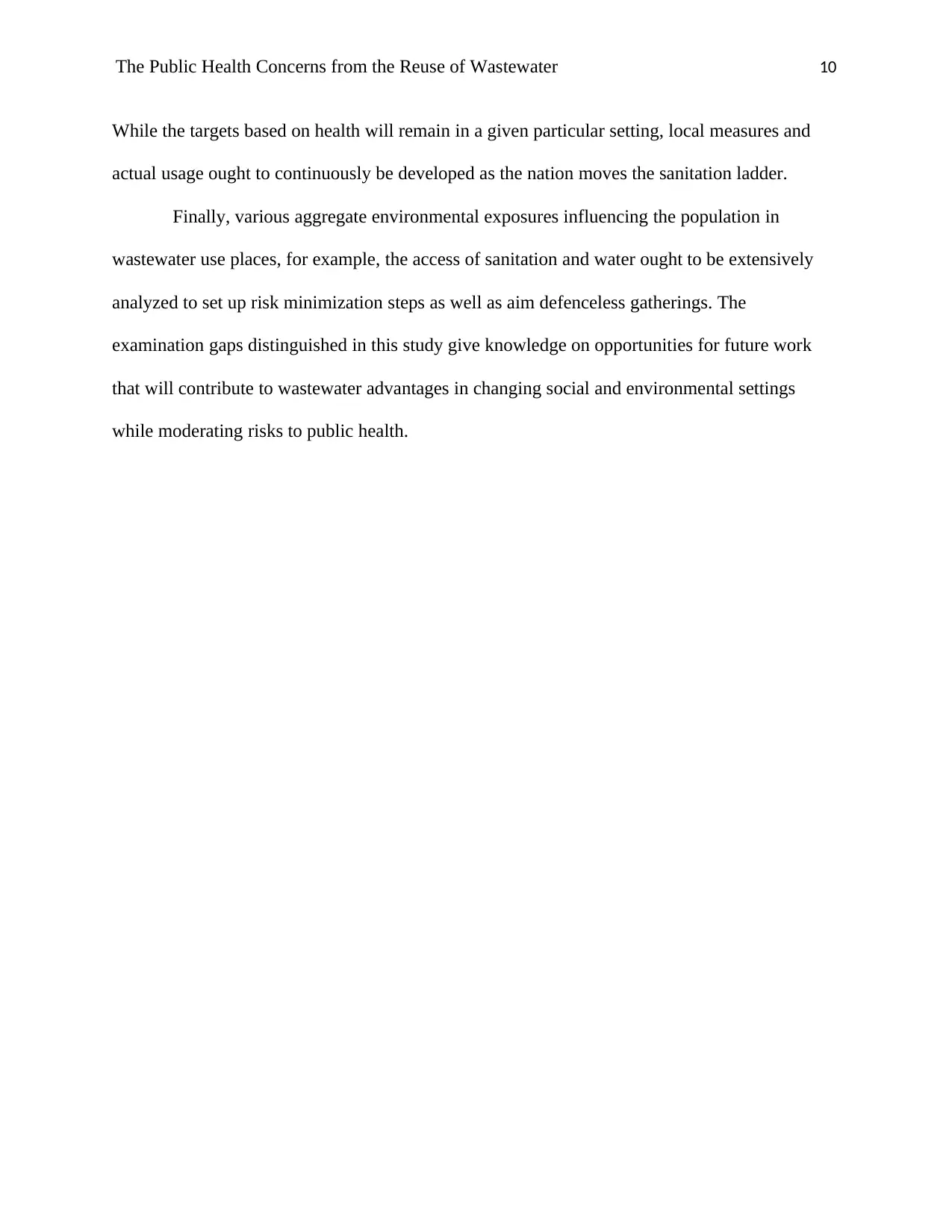
The Public Health Concerns from the Reuse of Wastewater 10
While the targets based on health will remain in a given particular setting, local measures and
actual usage ought to continuously be developed as the nation moves the sanitation ladder.
Finally, various aggregate environmental exposures influencing the population in
wastewater use places, for example, the access of sanitation and water ought to be extensively
analyzed to set up risk minimization steps as well as aim defenceless gatherings. The
examination gaps distinguished in this study give knowledge on opportunities for future work
that will contribute to wastewater advantages in changing social and environmental settings
while moderating risks to public health.
While the targets based on health will remain in a given particular setting, local measures and
actual usage ought to continuously be developed as the nation moves the sanitation ladder.
Finally, various aggregate environmental exposures influencing the population in
wastewater use places, for example, the access of sanitation and water ought to be extensively
analyzed to set up risk minimization steps as well as aim defenceless gatherings. The
examination gaps distinguished in this study give knowledge on opportunities for future work
that will contribute to wastewater advantages in changing social and environmental settings
while moderating risks to public health.
Paraphrase This Document
Need a fresh take? Get an instant paraphrase of this document with our AI Paraphraser
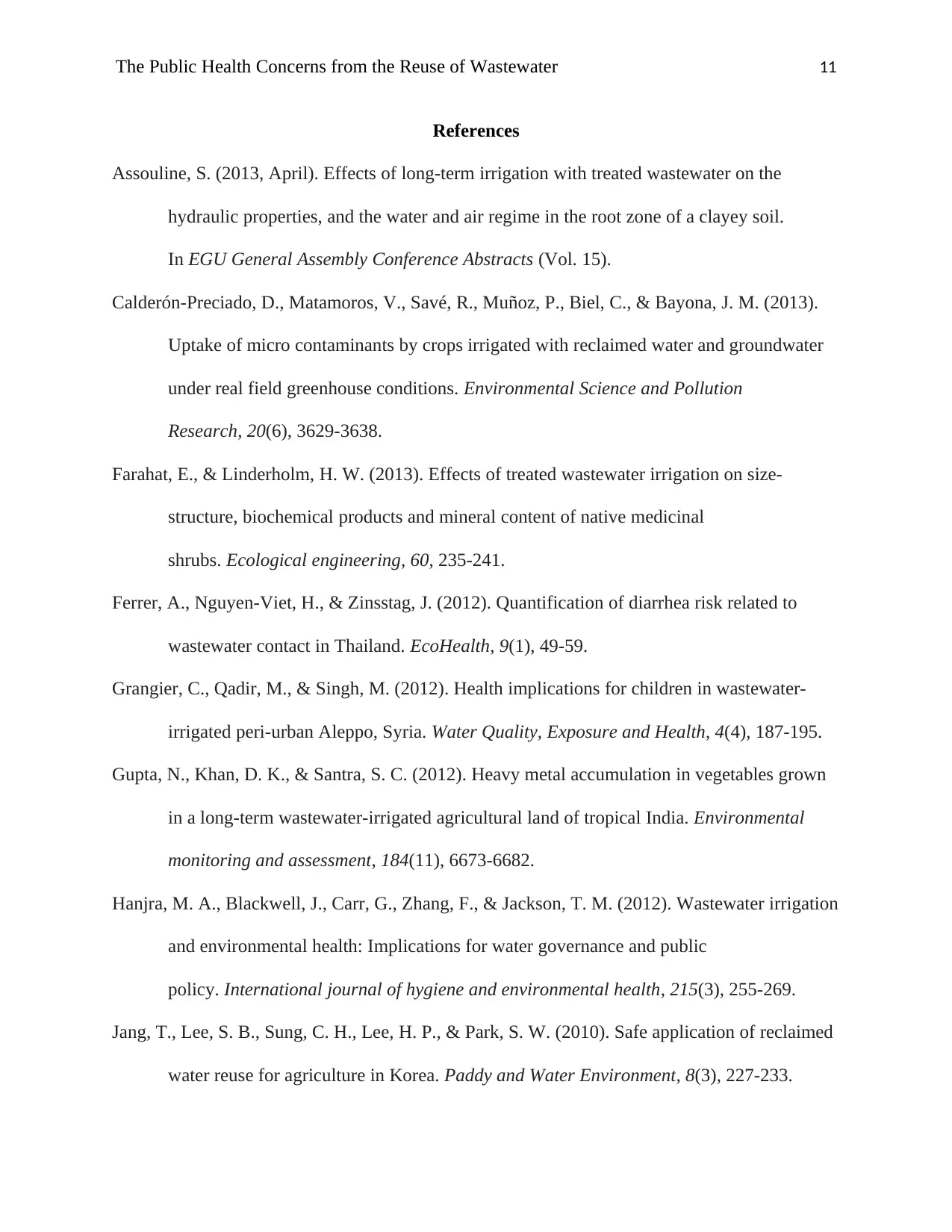
The Public Health Concerns from the Reuse of Wastewater 11
References
Assouline, S. (2013, April). Effects of long-term irrigation with treated wastewater on the
hydraulic properties, and the water and air regime in the root zone of a clayey soil.
In EGU General Assembly Conference Abstracts (Vol. 15).
Calderón-Preciado, D., Matamoros, V., Savé, R., Muñoz, P., Biel, C., & Bayona, J. M. (2013).
Uptake of micro contaminants by crops irrigated with reclaimed water and groundwater
under real field greenhouse conditions. Environmental Science and Pollution
Research, 20(6), 3629-3638.
Farahat, E., & Linderholm, H. W. (2013). Effects of treated wastewater irrigation on size-
structure, biochemical products and mineral content of native medicinal
shrubs. Ecological engineering, 60, 235-241.
Ferrer, A., Nguyen-Viet, H., & Zinsstag, J. (2012). Quantification of diarrhea risk related to
wastewater contact in Thailand. EcoHealth, 9(1), 49-59.
Grangier, C., Qadir, M., & Singh, M. (2012). Health implications for children in wastewater-
irrigated peri-urban Aleppo, Syria. Water Quality, Exposure and Health, 4(4), 187-195.
Gupta, N., Khan, D. K., & Santra, S. C. (2012). Heavy metal accumulation in vegetables grown
in a long-term wastewater-irrigated agricultural land of tropical India. Environmental
monitoring and assessment, 184(11), 6673-6682.
Hanjra, M. A., Blackwell, J., Carr, G., Zhang, F., & Jackson, T. M. (2012). Wastewater irrigation
and environmental health: Implications for water governance and public
policy. International journal of hygiene and environmental health, 215(3), 255-269.
Jang, T., Lee, S. B., Sung, C. H., Lee, H. P., & Park, S. W. (2010). Safe application of reclaimed
water reuse for agriculture in Korea. Paddy and Water Environment, 8(3), 227-233.
References
Assouline, S. (2013, April). Effects of long-term irrigation with treated wastewater on the
hydraulic properties, and the water and air regime in the root zone of a clayey soil.
In EGU General Assembly Conference Abstracts (Vol. 15).
Calderón-Preciado, D., Matamoros, V., Savé, R., Muñoz, P., Biel, C., & Bayona, J. M. (2013).
Uptake of micro contaminants by crops irrigated with reclaimed water and groundwater
under real field greenhouse conditions. Environmental Science and Pollution
Research, 20(6), 3629-3638.
Farahat, E., & Linderholm, H. W. (2013). Effects of treated wastewater irrigation on size-
structure, biochemical products and mineral content of native medicinal
shrubs. Ecological engineering, 60, 235-241.
Ferrer, A., Nguyen-Viet, H., & Zinsstag, J. (2012). Quantification of diarrhea risk related to
wastewater contact in Thailand. EcoHealth, 9(1), 49-59.
Grangier, C., Qadir, M., & Singh, M. (2012). Health implications for children in wastewater-
irrigated peri-urban Aleppo, Syria. Water Quality, Exposure and Health, 4(4), 187-195.
Gupta, N., Khan, D. K., & Santra, S. C. (2012). Heavy metal accumulation in vegetables grown
in a long-term wastewater-irrigated agricultural land of tropical India. Environmental
monitoring and assessment, 184(11), 6673-6682.
Hanjra, M. A., Blackwell, J., Carr, G., Zhang, F., & Jackson, T. M. (2012). Wastewater irrigation
and environmental health: Implications for water governance and public
policy. International journal of hygiene and environmental health, 215(3), 255-269.
Jang, T., Lee, S. B., Sung, C. H., Lee, H. P., & Park, S. W. (2010). Safe application of reclaimed
water reuse for agriculture in Korea. Paddy and Water Environment, 8(3), 227-233.
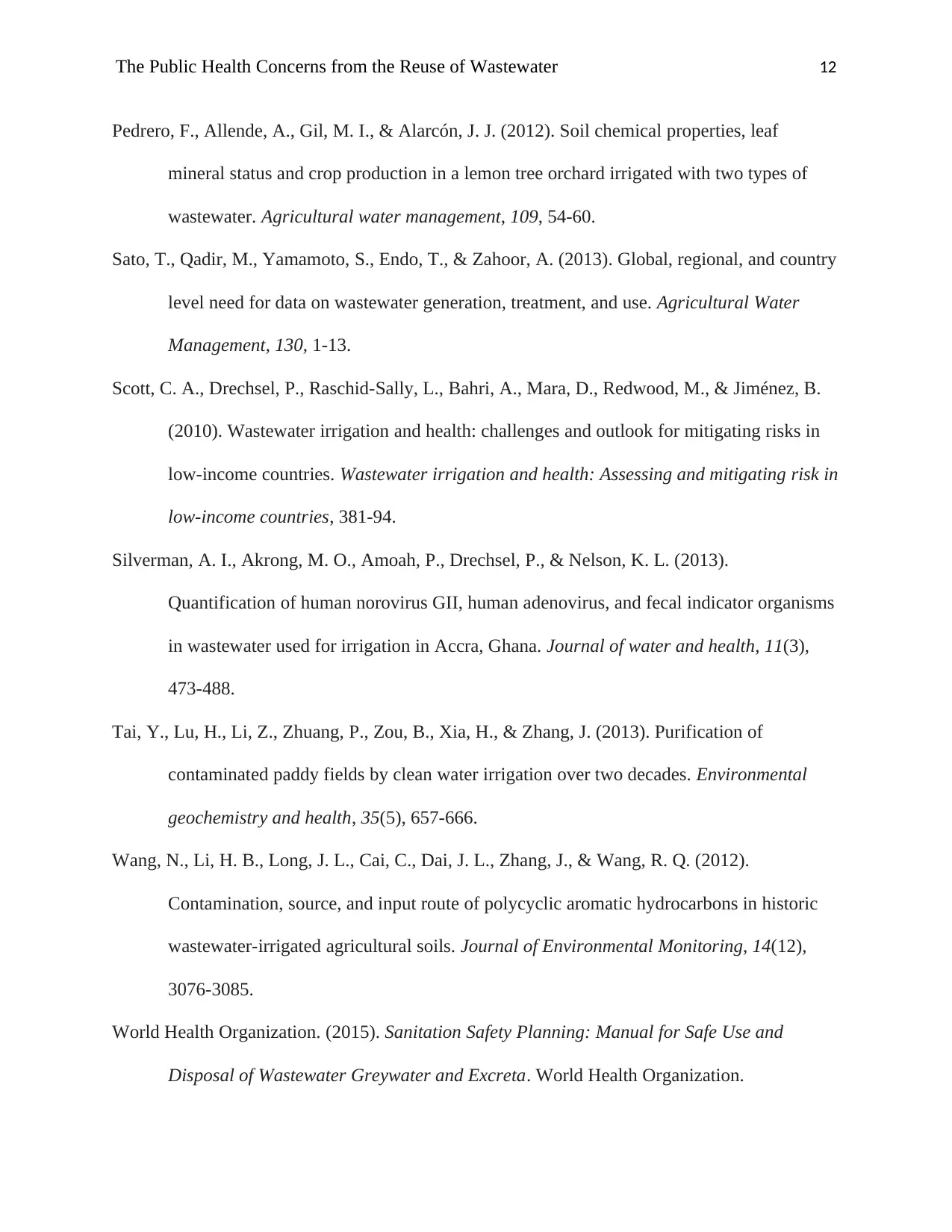
The Public Health Concerns from the Reuse of Wastewater 12
Pedrero, F., Allende, A., Gil, M. I., & Alarcón, J. J. (2012). Soil chemical properties, leaf
mineral status and crop production in a lemon tree orchard irrigated with two types of
wastewater. Agricultural water management, 109, 54-60.
Sato, T., Qadir, M., Yamamoto, S., Endo, T., & Zahoor, A. (2013). Global, regional, and country
level need for data on wastewater generation, treatment, and use. Agricultural Water
Management, 130, 1-13.
Scott, C. A., Drechsel, P., Raschid-Sally, L., Bahri, A., Mara, D., Redwood, M., & Jiménez, B.
(2010). Wastewater irrigation and health: challenges and outlook for mitigating risks in
low-income countries. Wastewater irrigation and health: Assessing and mitigating risk in
low-income countries, 381-94.
Silverman, A. I., Akrong, M. O., Amoah, P., Drechsel, P., & Nelson, K. L. (2013).
Quantification of human norovirus GII, human adenovirus, and fecal indicator organisms
in wastewater used for irrigation in Accra, Ghana. Journal of water and health, 11(3),
473-488.
Tai, Y., Lu, H., Li, Z., Zhuang, P., Zou, B., Xia, H., & Zhang, J. (2013). Purification of
contaminated paddy fields by clean water irrigation over two decades. Environmental
geochemistry and health, 35(5), 657-666.
Wang, N., Li, H. B., Long, J. L., Cai, C., Dai, J. L., Zhang, J., & Wang, R. Q. (2012).
Contamination, source, and input route of polycyclic aromatic hydrocarbons in historic
wastewater-irrigated agricultural soils. Journal of Environmental Monitoring, 14(12),
3076-3085.
World Health Organization. (2015). Sanitation Safety Planning: Manual for Safe Use and
Disposal of Wastewater Greywater and Excreta. World Health Organization.
Pedrero, F., Allende, A., Gil, M. I., & Alarcón, J. J. (2012). Soil chemical properties, leaf
mineral status and crop production in a lemon tree orchard irrigated with two types of
wastewater. Agricultural water management, 109, 54-60.
Sato, T., Qadir, M., Yamamoto, S., Endo, T., & Zahoor, A. (2013). Global, regional, and country
level need for data on wastewater generation, treatment, and use. Agricultural Water
Management, 130, 1-13.
Scott, C. A., Drechsel, P., Raschid-Sally, L., Bahri, A., Mara, D., Redwood, M., & Jiménez, B.
(2010). Wastewater irrigation and health: challenges and outlook for mitigating risks in
low-income countries. Wastewater irrigation and health: Assessing and mitigating risk in
low-income countries, 381-94.
Silverman, A. I., Akrong, M. O., Amoah, P., Drechsel, P., & Nelson, K. L. (2013).
Quantification of human norovirus GII, human adenovirus, and fecal indicator organisms
in wastewater used for irrigation in Accra, Ghana. Journal of water and health, 11(3),
473-488.
Tai, Y., Lu, H., Li, Z., Zhuang, P., Zou, B., Xia, H., & Zhang, J. (2013). Purification of
contaminated paddy fields by clean water irrigation over two decades. Environmental
geochemistry and health, 35(5), 657-666.
Wang, N., Li, H. B., Long, J. L., Cai, C., Dai, J. L., Zhang, J., & Wang, R. Q. (2012).
Contamination, source, and input route of polycyclic aromatic hydrocarbons in historic
wastewater-irrigated agricultural soils. Journal of Environmental Monitoring, 14(12),
3076-3085.
World Health Organization. (2015). Sanitation Safety Planning: Manual for Safe Use and
Disposal of Wastewater Greywater and Excreta. World Health Organization.
⊘ This is a preview!⊘
Do you want full access?
Subscribe today to unlock all pages.

Trusted by 1+ million students worldwide
1 out of 13
Related Documents
Your All-in-One AI-Powered Toolkit for Academic Success.
+13062052269
info@desklib.com
Available 24*7 on WhatsApp / Email
![[object Object]](/_next/static/media/star-bottom.7253800d.svg)
Unlock your academic potential
Copyright © 2020–2025 A2Z Services. All Rights Reserved. Developed and managed by ZUCOL.





